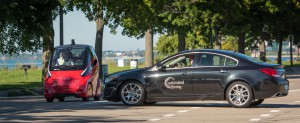
Testing and developing connected and automated vehicles like these will be the focus of the Mobility Transformation Center at the University of Michigan.
More than a dozen companies are throwing their support – and dollars – behind the University of Michigan’s Mobility Transformation Center and its plans to research and develop connected and automated vehicles.
A mix of automakers, suppliers, communications and technology companies – called the Leadership Circle – have pledged more than $1 million during the next three years to help the center, also known as the MTC, expand research program. Additional companies, known as affiliates, are also participating.
“We are on the threshold of a transformation in mobility that the world hasn’t seen since the introduction of the automobile a century ago,” said Dr. Peter Sweatman, director of the MTC.
Delphi Corp., Denso Corp., Econolite Group Inc., Ford Motor Co., General Motors Co., Honda Motors Co., Iteris Inc., Nissan Motor Co., Robert Bosch L.L.C., State Farm Mutual Automobile Insurance Co., Toyota Motor Co., Verizon Communications Inc. and Xerox Corp. comprise the Leadership Circle.
The MTC opened in late Spring to research and develop the technology needed for vehicles and infrastructure to continue the automation of cars and trucks with a focus on reducing or eliminating crashes.
Part of that research includes the study of 3,000 cars called the Connected Vehicle Safety Pilot Model Deployment, a U.S. Department of Transportation (DOT)-sponsored program designed to demonstrate connected-vehicle technologies in a real-world, multimodal environment covering 73 miles of roads in northern Ann Arbor, Michigan, dubbed the Mobility Transformation Facility. It is expected to open this fall.
(U-M escalating connected car research. For more, Click Here.)
Sweatman believes the goal of accident- and injury-free driving cannot be achieved without commitments from government, the private sector and university researchers. He’s not alone in this belief.
Ford Motor Co. Executive Chairman Bill Ford said during an appearance last week that collaboration among carmakers, suppliers and companies from other sectors of the economy is one of the keys to the development and enhancement of vehicle-to-vehicle communication and reducing.
(Click Here for details on NHTSA’s chief’s dressing down before senators.)
Osamu Nagata, president and chief executive officer of Toyota Motor Engineering & Manufacturing North America, also said during a recent seminar on safety that progress towards collision-free driving will requires cooperation on several levels.
The early results from the MTC’s connected vehicle research project are the basis for the rules being developed by the National Highway Traffic Safety Administration for connected vehicles. Connected vehicle technology, including vehicles that can communicate with one another and with the surrounding infrastructure, has the potential to eliminate the majority of serious crashes when extensively deployed, according to safety experts both in the private and public sectors.
(To see more on Bentley’s Ferrari competitor: the Mulsanne Speed, Click Here.)
However, key issues such as cost of installation and maintenance as well a technical standards remain unresolved, they also have noted.
The MTC plans to expand the original DOT project in Ann Arbor, which involved 3,000 vehicles to involve 9,000 vehicles 2016. It is also working with the Michigan Department of Transportation and industrial partners to provide the infrastructure need in Southeast Michigan to support deploy as many 20,000 connected vehicles.
The goal also to have fully automated or autonomous vehicles available for use on U-M’s campus as the scope of the research continues to evolve, U-M officials said.
